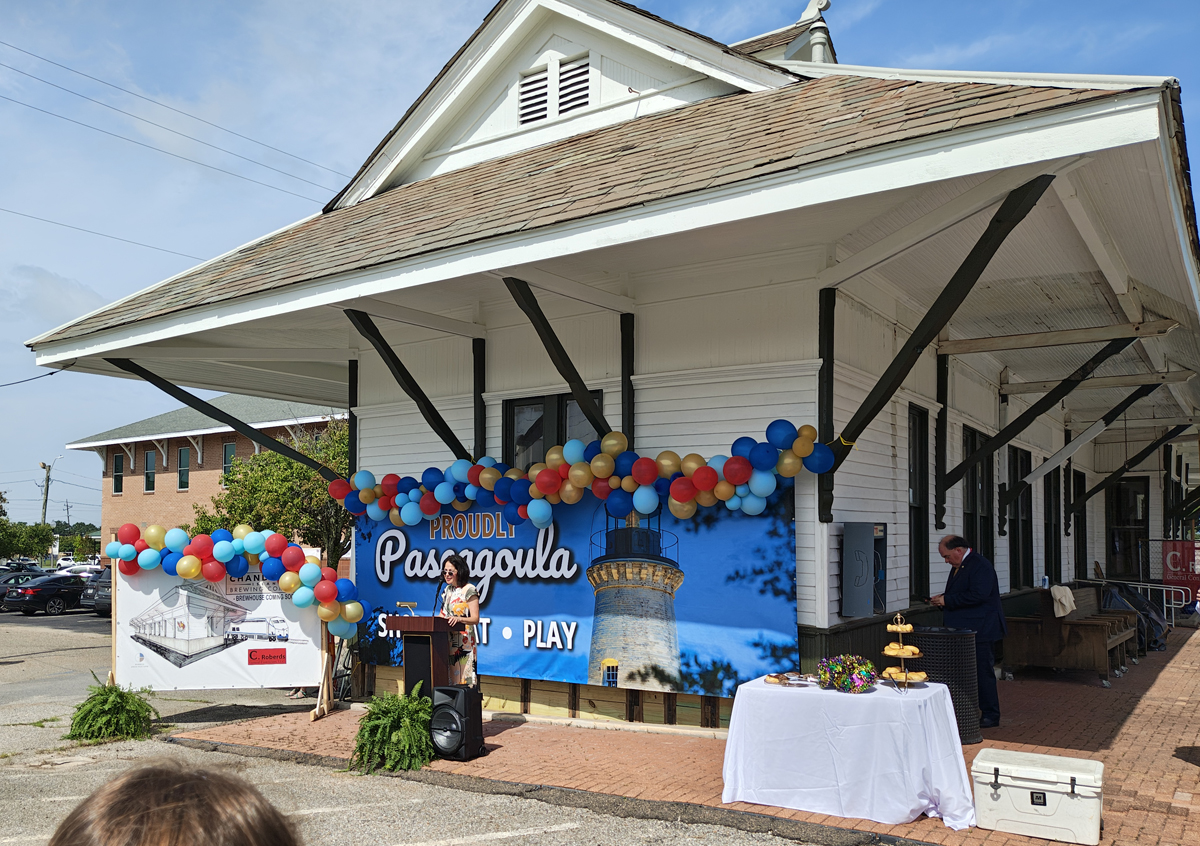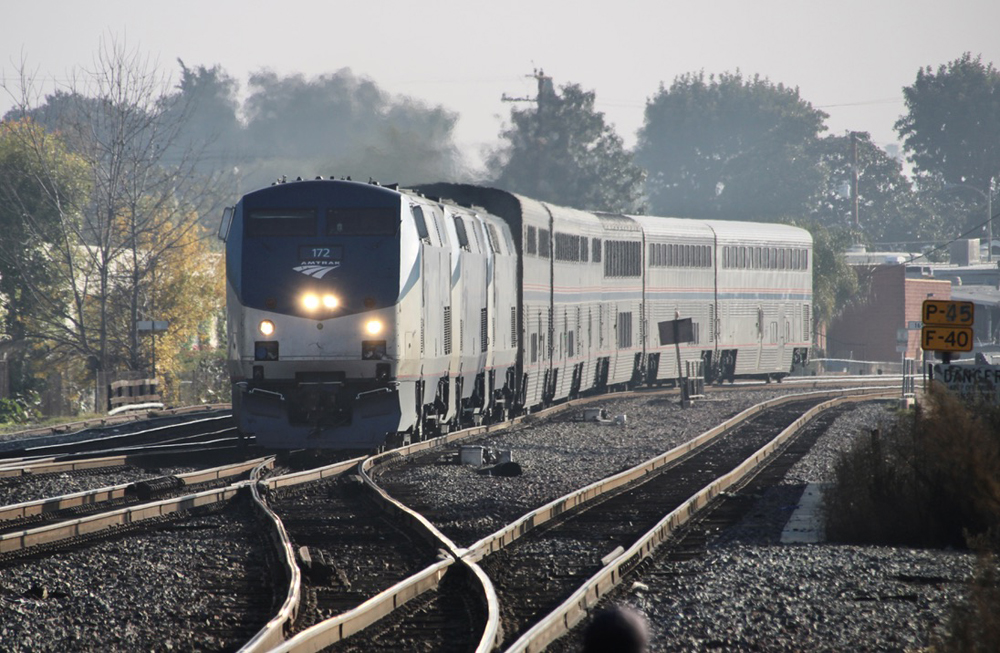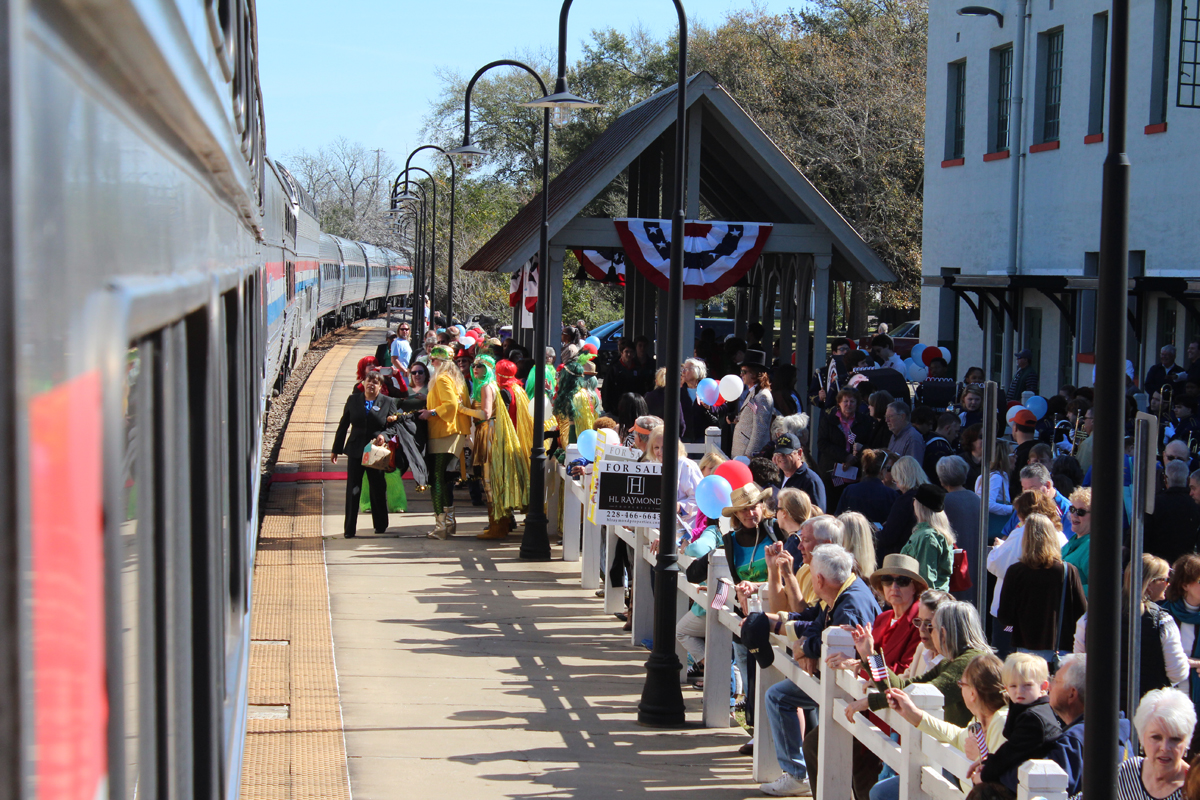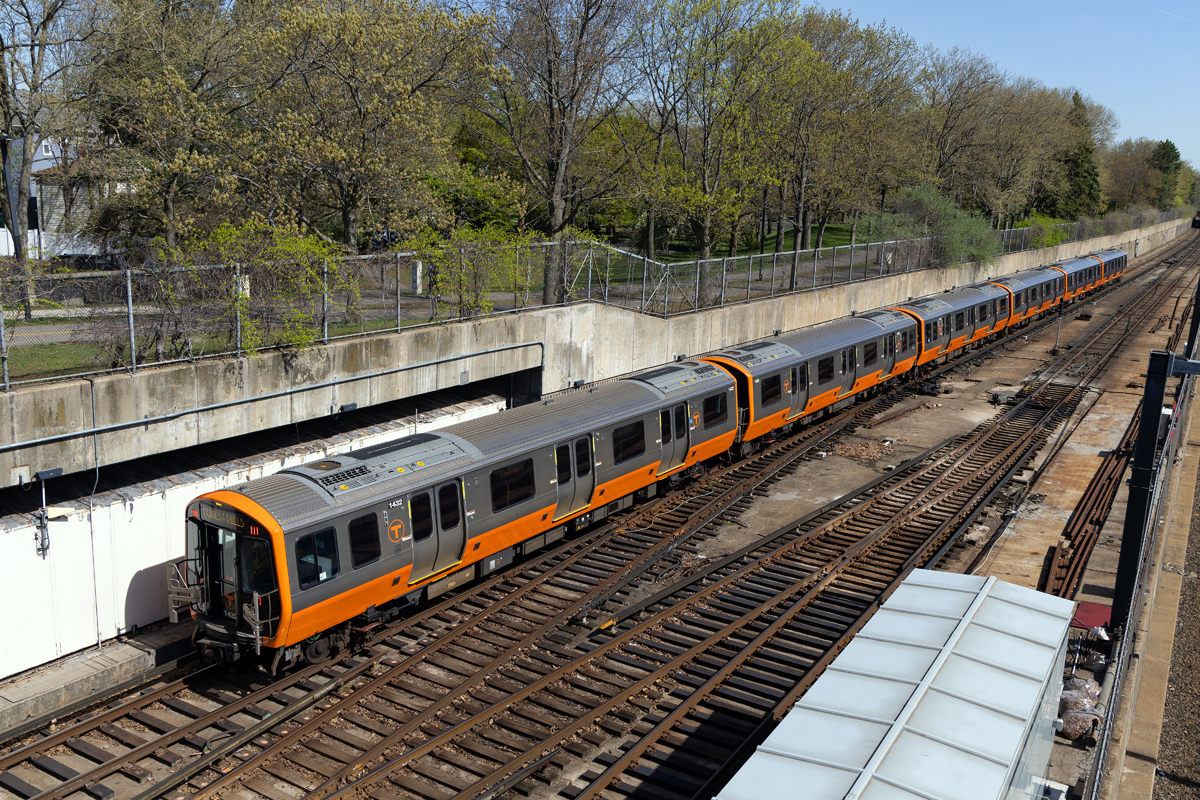BOSTON — Delays were continuing this morning on one Massachusetts Bay Transportation Authority line after a Thursday afternoon derailment of an outbound commuter train.
No injuries were reported when the Framingham/Worcester train derailed near the Lansdowne station in Boston’s Fenway neighborhood. Keolis Commuter Services, the contract operator of MBTA commuter trains, described the accident as “a low-speed upright derailment,” the Boston Globe reports. Photographs indicate that only the cab coach of the train derailed.
The accident occurred about 4 p.m. and led to significant delays during the Thursday evening commute. Delays of 20-30 minutes were being reported Friday morning as track repairs continued at the derailment site.
The derailment comes a few weeks after release of a highly critical report on MBTA safety practices [see “Panel’s report says ‘safety is not the priority’ at MBTA,” Trains News Wire, Dec. 10, 2019], although that report was aimed at MBTA transit operations and largely exempted Keolis from its criticisms.















Charles- The B&A Trinity Place station was one of their stations designed by H.H. Richardson, noted architect. One of these stations which survives today is at Allston and is the “Allston Depot” sports bar. Needless to say, it’s fenced off from the tracks in back.
Charles – An interesting fact about the NYC – Boston & Albany uptown stations near Copley Square and the NH Back Bay Station: the platforms were not opposite one another. If you walked to the west end of the Trinity Place station platform (westbound side) you would see the eastern end of the Huntington Avenue (eastbound side) station platform across the two tracks. Yes, I think that there was no actual station building at the Huntington Avenue station, but I’m not 100% sure of that. When these stations were demolished in early-1960s, a new platform was built at the edge of Back Bay Station along the B&A track so that NYC passengers could access Back Bay Station. In Back Bay station today there is ample platform space for both ex-NH passengers and ex-NYC passengers, as well as the MBTA Orange Line.
RON – From the photo I vaguely recall (I don’t recall ever actually seeing the station) Trinity was your classic small-city/ big suburb Victorian depot. Seemed out of place in modernistic Back Bay, Boston’s second downtown. Then again the railroad structure surely predated modernistic Back Bay probably by a number of decades and several architectural fads.
All the stations were (are) a bit removed, two or three blocks, from what we think of as the Back Bay high-rise district. There were or are a couple of blocks of more architecturally mixed low-rise development by the tracks.
RON –
Here’s some more B&A trivia. There were three stations (one New Haven, two B&A) where there now is one station, Back Bay. The New Haven called at Back Bay. Very nearby, the B&A called at Huntington Avenue eastbound and Trinity Place WB. If I recall correctly from photographs published, Trinity had an actual depot but Huntington was a platform only. All this got buzzed out when the early 1960’s construction of the Mass Pike Boston extension reduced the B&A to one track and no room for depots.
According to a 1957 official guide, the two B&A stations weren’t just commuter platforms but like the New Haven’s Back Bay served the intercity trains.
The current Back Bay station strongly resembles the old New Haven Back Bay station but is newer construction to serve the former New Haven and the former B&A routes, plus the relocated MBTA Orange Line subway.
I only rode the New York Central once, around 1962, Boston South Station to Framingham one way (though I rode Penn Central trains with NYC equipment on ex-NYC routes after the 1968 merger). This was during construction of the Mass Pike, which as a budding freeway engineer at age about fifteen I found fascinating.
Something that has always puzzled me is that among all Americans, it’s only Bay State natives that called the state “Mass”. I don’t know how old I was before I heard the oversized full name, Massachusetts. Hey, a least we didn’t live in the ten-syllable, 35-letter state to the immediate south.
Ron, to your point, the Guide lists the following main line stations (i.e. not the Riverside Branch): Boston (meaning South Station), Trinity (WB) or Huntington EB, University, Allston, Brighton and Fanueil, all in Boston. In Newton there were five stations, three in Wellesley then Natick, and finally Framingham at Mile 21.4. An all-stops local took one hour, twenty-seven minutes to go those 21.4 miles. In the days before the Mass Pike, there really wasn’t a better choice.
Lansdowne station (ex-Yawkey station) dates from recent years and is not one of the Boston & Albany local stops from the old days. Example- there was a station at the west end of the Boston University campus, with wood platforms sheltered by the Commonwealth Ave bridge overhead. That station lasted into the 1950s. Lansdowne is located at the former junction with the B&A Highland Branch, which was converted around 1959 into the MBTA light-rail Riverside Line. Trains on this line in the 1950s consisted of old steel coaches pulled by NYC Alco RS3’s. In the 1940s and earlier, motive power was B&A 2-6-4T and 4-6-4T suburban tank steam locos.
As a boy in the 1940s I attended Red Sox games and the Fenway Park stadium in those days was different in that if you sat in the right-field seats you could look across and see the tracks. You can’t do that today. I saw steam locos backing down to their trains at South Station and there must have been a signal there because they sometimes stopped. But there was no station there. That came about in recent years when the MBTA decided to put a station there to serve the Kenmore Square area as well as the Fenway Park. The station was named “Yawkey” because the street next to it was Yawkey Way, formerly Jersey Street. I guess they could have named it “Fenway” or “Kenmore” and avoided all of this political INcorrectness.
Another Boston baseball park with good rail views was Braves Field (now owned by Boston University).The Boston & Albany main line passed right below its outer wall, and there were great views of the Beacon Park yard and the B&A’s twin roundhouses beyond. Out front, there was a spur track and siding for MTA trolley cars which ran off from the Commonwealth Avenue line.
GEORGE You’re reading Sporting News,
Am I reading “Sports Illustrated” or Trains magazine? I’m confused…albeit a short trip.
ANNA – Sorry ’bout your parents. Mine were the opposite. When I was a child, the only integrated place in suburban Norfolk County was the Town of Randolph (now City of Randolph). Living in then all-white Sharon there was little my parents could do to make Sharon the second integrated town in Norfolk County but they sure tried and were happy when it happened.
Quincy, then the only city in Norfolk County, may then have been among America’s largest all-white communities but is now largely Chinese and Black. At one time or another, my entire family has lived in Quincy including myself.
Of course “all-white” means different things in America’s racism. Ted Williams, the biggest hero of those “all white” Red Sox, was 50% Mexican American. The supposed all white brigades in the US Army had numbers of Hispanics and Native Americans providing a sufficiently light skin tone. Supposedly all-white Quincy included an Arab population neighborhood.
Myself, I was living in Detroit. I made many black friends and got along beautifully with my neighbors in integrated districts of the city. Instead of sitting among low-life Red Sox fans in Fenway Park, I had the privilege of watching my favorite Baltimore Orioles come to play the Detroit Tigers. Two thoroughly integrated ball teams. In the days before interleague play, I think I watched just about every American League team at Tiger Stadium, the exception being of course the Red Sox.
Mister Landey:
You want racist, I’ll give you racist.
My father was from southern Oregon, my stepmother from far southeast Oklahoma. In the day Ashland Oregon, home of the Shakespeare Festival, was so racist that the command at the local Army camp put the whole area off-limits. Too many of the soldiers were coming back to base in an ambulance. The locals also would delight in catching one of the Shakespeare actors and beating [deleted] out of him just because they could.
As for far southeast Oklahoma, there was a reason it was called “Little Dixie”. It truly was the buckle on the Bible Belt and not where you wanted to be if you were anything but white, Baptist, moneyed, and male.
One good thing about the californication of Oregon is that, at least in the Willamette Valley, these attitudes have been somewhat moderated. But in the Rogue Riger area and in eastern Oregon, they are still there, still rampant, and they still have sundown towns. Don’t get caught, for example, in Fossil after dark if you are gay, not Baptist, or anything other than white. Those people truly know how to hate.
I can’t speak for McCurtain County as I was never there voluntarily and after I left home I never went back.
My parents egged on the Watts riots and threw a party – they actually threw a party – when Martin Luthur King was killed.
That’s racist.
As for me, I have lived all over the world. One thing I have learned is that every one of us is pretty much the same – we all put on our pants one leg at a time. And I can get along with pretty much anyone.
Back to the derailment (reminder, this all started with a derailment), it is good that nobody got hurt, but MTBA is developing an image problem and unless they take immediate action it will only get worse. First there was the report stating that safety is not a priority at MTBA, now on the heels of that a derailment. You think the public doesn’t notice these things? Think again. MTBA upper management is on thin ice here and they cannot not know it.
The above comments are generic in nature and do not form the basis for an attorney/client relationship. They do not constitute legal advice. I am not your attorney. When shall we meet again? In riot, strike, or stopping train?
About the derailment, ooops.
Charles,
Let’s put it this way: in the 30 years before Yawkey bought the Red Sox, the team won 5 championships. In the 27 years since Jean Yawkey’s death, they’ve won another 4 championships. For almost 60 years In between, zilch. Besides Jackie Robinson, who knows how many great hall-of-fame players or coaches the Yawkeys passed on just because they weren’t white? The fact is that he put his personal bigotry above winning baseball games to the point where he claimed he lost $10 million while owning the team. He would have won more games and made a lot more money doing so if he had put the best talent on the field rather than the best *white* talent on the field.
Re: Jim Crow laws and railroads, what about them? The railroads complied with the laws they had to comply with. The “sin” is with the state governments for enacting these laws in the first place, US Congress for not superseding these laws until 1964/65, and with the US Supreme Court that ruled that the Jim Crow “Separate But Equal” laws were legal in 1896 in “Plessy vs. Ferguson.”
The issue here is that Yawkey was being *honored* by having both a street and a train station stop named after him and his wife. That honor has been rescinded due to their bigoted past and the covering up the sexual abuse of minors by their long time employee. That’s all it means. It doesn’t mean anyone is going to abolish political parties, abolish the MBTA, scrap the Big Boy, or shut down all railroads due to their past historical actions by people long dead. No one is talking about abolishing the Red Sox, are they?
PAUL – Really no argument with you and thanks for reading my post. I totally agree the city of my birth was the shame of hell when it came to its Afro minority. The stories I could tell — like being in the downtown shopping district and seeing only white faces, as if downtown Boston were a niet swartzes district of Pretoria or Johannesburg.
Thanks for your comments about Yawkey. Maybe I should have paid more attention to the creep’s creepiness. I was too busy hating the Red Sox to care but it’s clear I should have known more about Tom Yawkey. Best had the train station not been named for him in the first place, if he was such a rat and did nothing for the team. It’s inexplicable that this was the name in the first place.
My point stands though. If you criticize Yawkey what do you have to say about Jim Crow on those railroads we love so much?
Charles, oh puh-leeze. For one thing, the Yawkeys were lousy baseball owners. The Red Sox never won anything during their entire 59 year run of ownership. But that’s the least of it.
Not only were the Red Sox the last team to integrate, they did it 12 years after Jackie Robinson’s MLB rookie season and over 2 years after Robinson had retired. In 1945, they gave Robinson a farce of a tryout to appease a city counselor who threatened to revoke the Blue Law exception (so they could play on Sundays). Even with the tryout attendance limited to Red Sox management, they heckled Robinson with racist slurs. Do you honestly think that there wasn’t one black player in 12 seasons that could play for some pretty so-so Red Sox teams? They were mediocre for almost all of the 1950’s, never finishing a season higher than 3rd place. Robinson himself (a man who withstood some of the most awful racist behavior from tens of thousands of people) said that Yawkey was “…one of the most bigoted guys in baseball.”
Even 12 years after breaking the color barrier in MLB, Yawkey had to be sued by the Massachusetts Commission Against Discrimination to promote a black player from the minors. In short, Yawkey was so bigoted that he had to be forced to field a black player. It’s so bad that even today, when someone asks which city is the most racist, Boston is invariably listed. When asked why, the person usually lists the Red Sox being the last team to integrate as one of the reasons. Nobody remembers that the Boston Celtics were the first team to draft a black player (in 1950), first team to start all 5 black players on the court (1964), and first team to hire a black head coach (1966). None of that is recalled because Yawkey wouldn’t have a black player on his team until he was forced to in 1959.
Then there’s the multiple occasions of underage sexual abuse that happened for 20 years during Red Sox Spring Training at Winter Haven, FL between 1971-1991 by a longtime clubhouse attendant Donald Fitzpatrick. The abuse was reported to both Tom and Jean Yawkey, but they both protected the clubhouse attendant and kept him employed so he could abuse more kids for decades. Fitzpatrick pleaded guilty in 2002.
Do you really think it’s acceptable to honor a family with street and train station names that were terrible at owning a baseball team, had a racist bigot in charge for decades so notorious that it is still a black eye for the city, and who were also child sex abuse enablers? I don’t. I think it’s horrible. I acknowledge this reality about Yawkey, and yes, I am a Red Sox fan. I don’t care how much money they gave to charity.
Changing the name of the station does not erase history. It simply no longer honors a name that was never worth being honored in the first place.
RON SALTERS …. Oh, is that where Landsowne Station came from? Yawkey Station was politically incorrect because the Red Sox was the last team to take on a Black player and Tom Yawkey was then the owner. I suppose we could rename everything in the US named after an actual racist or a perceived racist. We could start by abolishing the Democrat party, the party that started the Civil War, and the party of slavery and Jim Crow. Then we could continue by removing from the map all-Democrat Washington State which was named after a major slave owner.
Then we could continue by abolishing the MBTA itself. It was well known the its predecessor MTA (pre-1964) wouldn’t hire a black American for any job more skilled than taking out the trash. And of course we could shut down the entire railroad system, which was the most segregated industry on the face of the earth. Also to go would be all of us railfans reading this stuff each day … how many black T+E crews on that Big Boy? The longest – lasting major railroad name is Union Pacific, a name that needs to be changed because like all railroads African Americans advanced no further than dining car waiters and sleeping car porters.
We could continue by abolishing my late parents, who although they abhorred segregation and spent their lives working against discrimination, were Red Sox fans. (I’m not, which is why I was thrown out of Massachusetts where I was born and raised.)
Renaming Yawkey Station doesn’t change America’s past. Rather, it’s the purchase of an indulgence.
The “Lansdowne station” is the new name for the former Yawkey station near Fenway Park.